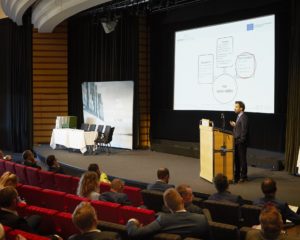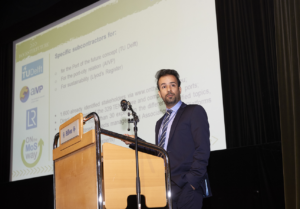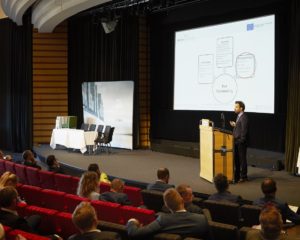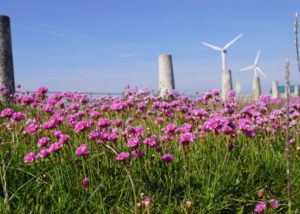New scenarios in the Mediterranean: Suez and China, the strategies of big carriers, new technologies, and energy routes.
Italian Maritime Economy

The Suez Canal has just celebrated 150 years of operations. Its 2015 enlargement established new port balances in the Mediterranean: the two records broken in terms of number of ships and goods transited (18,000 vessels and almost 1 billion tonnes) have a deeper meaning than mere statistics. A closer look at maritime areas reveals the increased importance of East-Med ports (over a 5-year period, +40% and +7% of southbound and northbound traffic, respectively) and an upward trend in container and tanker traffic which seem to indicate increased centrality of the Mare Nostrum in terms of manufacturing and energy trade flows.

Furthermore, the phenomenon of naval gigantism does not seem to stop, and the most reliable forecasts indicate further future growth. In particular, orderbooks show that 133 new containerships in the 10-23,000 TEU category will be launched by 2022 and 45 of these will belong to the 18-23,000 TEU category. Also, rumors seem to indicate that a Mega-Megacontainership will be ordered by COSCO with a capacity of 25,000 TEU. The criteria for the selection of ports in the MED area will probably become more stringent. While this analysis was undergoing, SRM found only 4 ports capable of accommodating this type of ship. Therefore, it seems clear that smaller ports will be
concentrating on feeder traffic and medium-sized vessels as their core business, despite the need to implement dredging to increase capacity.
The scenarios outlined in this Report also illustrate the implementation status of China’s Belt & Road Initiative which indicates the end of the previous aggressive Chinese approach to terminal acquisitions in the Mediterranean and Northern Europe. The Asian giant’s position has been strengthened in the East Med (Piraeus), West Med (Valencia), access canals to the Black Sea (Istanbul), the Mediterranean (Suez) and in Northern Europe (Rotterdam) where intermodal capacity allows to reach the central-European markets. Further significant investments have been made in Abu Dhabi, Marseille and Malta while an MoU was signed with Italy at the end of March 2019 which will lead to investments in Italian ports (ie Genoa and Trieste) as well as in other sectors such as rail transport, intermodality and logistics. Debate on railway connections to/from China is still open in our country and there seems to be an intention not to miss out on this opportunity.

This Report also takes a closer look at Shortsea traffic which represents one of our country’s strengths. Indeed, Italy has a 36% market share in this type of traffic in the Mediterranean. Also, Ro-Ro in Italy amounts to more than 100 million tonnes of goods, 50% of which handled in the Mezzogiorno, and represents a strong sector of our maritime economy with excellent shipowners and a worldwide network of terminals. This needs to be continuously supported so as to avoid losing market shares in an area where our know-how is solid and well established.
Therefore, according to SRM’s analyses, the idea of a Portuality 5.0 is the new key to interpret port roles. A modern port intending to be an active player in the international competitive situation needs to be moving faster than the industry because it needs to serve it adequately and efficiently while contributing to the growth of the local territory
through attraction of investments that create jobs and boost the economy.
The port needs to encourage the growth of businesses by offering efficiency and streamlined internationalization processes which are generally speeded up whenever ships are allowed to reach destinations in short times thanks to high-quality direct services. All of this makes the port the engine of a country’s import-export.
Furthermore, a port needs to increase its ability to stimulate the creation of new businesses and start-ups. In particular, port models such as those of the Northern Range are increasing activities aimed at encouraging the growth of companies in terms of business but also of creation of companies.
Another important driver is represented by intermodality which has long been hoped for in Italy but still remains a goal to be achieved since a successful integration of ports, dry ports, roads and railways has not been completed yet. An analysis carried out by SRM in collaboration with Contship Italia (Corridors and logistic efficiency of
territories) revealed that only 19% of manufacturing companies in three major Italian regions use a mixed modality of transport (road-railway) to move goods between the port and their warehouses. Working on this aspect could represent the key to improving logistics in our country.
Cooperation between the port and the world of economic research should also be taken into account. A modern port must be aware of the dynamics of traffic and the phenomena that surround it, while avoiding isolation and strategies unrelated to those of the national system. SRM has long been supporting the whole maritime system also
through its network of partners with the aim of helping the implementation of works and research that could promote awareness and discovery of new frontiers of development and of the changes happening in the Mediterranean in terms of trade flows.
Last but not least, it is important to highlight the ability a port needs to show with regards to its role as driver of the territory. In particular, the introduction of SEZ (Special Economic Zones) in our regulatory framework has required portuality to make the effort of becoming a mainstay of the crucial connection between industry and logistics. In this
way, the port becomes a catalyst to the import-export of the territory and therefore one of the main engines of economic development.
Italian ports, after a difficult season determined by a complex reform which is still undergoing, are trying to find new competitive momentum and the new presidents are working hard to design and implement new strategies through the identification of the role that Port Network Authorities will intend to play in this situation. Our ports need new
stimuli and renewed awareness of the importance of logistics and intermodality in pursuit of a role at the service of industry and tourism supporting maritime operators who wish to further develop. In this context the Mezzogiorno, which activates about 50% of port traffic of the country and whose two thirds of international trade are carried out by sea, needs to be put in a significant position with appropriate investments and strategies. Southern Italy
boasts a geographic position close to the Suez Canal and on the routes connecting the markets of Northern Europe, the Middle and Far East. This is an important fact to take into account when considering the role that this area can play in terms of economic growth of the country.
This is exactly the scope of SRM’s contribution to a deeper understanding of such complex, articulated and constantly changing phenomena. The world of the sea moves at a fast pace and the maritime-economic aspects need continuous monitoring alongside the changes that they can produce. This Report, in fact, is only a part of the several in-depth analyses, papers, interviews that the Observatory on Maritime Transport and Logistics carries out and which it will continue to perform in order to keep the attention high on our maritime transport sector. Also, for this issue of the report, SRM has operated in synergy with national and international centres of study which have used their specific know-how to enrich and further validate the contents of these papers.
SRM is a member of the Global Shipping Think Tank Alliance together with 16 other centres of research in Europe, the US and the Far East. We are proud to be the only Italian centre of maritime research, and one of the four European ones to be part of this important network. We have also established relations with the KLU-Kuhne Logistics University of Hamburg, the Universities of Rotterdam and Antwerp and with the OECD.
Also noteworthy is another agreement signed by SRM with the Energy Department of the Polytechnic of Turin with which new global energy routes are being analysed. This year, as a sign of increased prestige for the Report, the research team can pride itself with the presence of two renowned papers elaborated by the Port Network
Authorities of the Central Tyrrhenian Sea and Northern Adriatic Sea. These institutions have demonstrated to share our point of view in terms of the messages that this volume intends to send, as illustrated by its title which highlights a growing and increasingly central Mediterranean.

Another strength of this Report is represented by the collaboration with Sea Europe, a network comprising the main European players of the sector of shipbuilding, another significant field of the maritime chain. In conclusion, it seems crucial, for our research policy, to stay connected and to network with other Italian and foreign centres of research but also with operators who can complete the Report with their experiences so as to make this volume a reference publication for the sectors of ports and shipping.
As for the structure of the Report, it is organized as follows:
The first chapter contains an analysis of the current situation with the most important economic data, international and national port traffic with details as to the ports, canal transits, short-sea, and a focus on the Suez Canal and on import-export in our country.
The second chapter takes a closer look at Ro-Ro, one of the main sectors for the Italian maritime world, by providing detailed analyses of Car Carrier vessels, which transport new cars.
After that, the third chapter has been elaborated by a team comprised of members of the Polytechinc of Hong Kong and SRM. This work takes into account current and future scenarios of Global Container Carriers through an analysis of their fleet, orderbook and financial performance while also considering the effects of the IMO Sulphur cap 2020 on reduction of Sulphur emissions from ships, a phenomenon that will significantly reshape maritime investments. This chapter is closely linked with the fourth one, elaborated by the OECD, about the Big shipping alliances. This topic has long been one of SRM’s focus points as this phenomenon is markedly affecting routes and the global logistic situation.
Furthermore, Sea Europe have elaborated the fifth chapter on European industry and maritime technologies, a sector that is amongst the most important ones in the world in terms of aggregate production value (€ 112.5 billion), accounting for over 23% of global production value and generating over 900,000 direct and indirect jobs.
Pino Musolino, President of the Port Network Authority of the Northern Adriatic Sea (Venice and Chioggia) analyses with detail the phenomenon of China’s Belt & Road Initiative, focusing on future strategies and impacts in the Mediterranean and in Italy with very interesting considerations and analyses.
In the seventh chapter, Pietro Spirito, President of the Port Network Authority of the Central Tyrrhenian Sea (Naples, Salerno, Castellammare), focuses on the energy future of ports. The energy component is one of the crucial variables for the competitiveness of economic systems and for the structure of international trade. The maritime sector represents an important articulation of it, as a result of the exchange flows that are determined between producer and consumer countries.
The eighth chapter has been elaborated by the SISI (Shanghai International Shipping Institute), one of SRM’s partners. This piece of research is mainly focused on Dry Bulk, through the analysis of routes and future prospects in the Far East, as this specific sector is capable of influencing trends in the maritime trade.
Finally, chapter nine has been written by the Consiglio Nazionale dei Dottori Commercialisti (National Council of Accountants) and illustrates the results of the Observatory on balance sheets of maritime businesses. It highlights a fast-paced growth that results in increases of employment (+1.3%) and of revenues (12.6%), figures which
seem even more remarkable if compared with the overall growth of turnover of Italian SMEs, which amounted to 5.3% in the same period.
We wish to conclude this introduction to the volume with a special thanks to SRM’s researchers and to the partners of this project who demonstrate their faith in our work and support us in this adventure we have embarked upon. A special thanks goes to all the authors who have contributed to adding to the value of this research.
Hoping we have been able to provide factual support to those convinced that the development of the economy of maritime transport and logistics is a priority for our entire country. The challenge is still ongoing.
Massimo DEANDREIS
Source: https://www.srm-maritimeconomy.com/
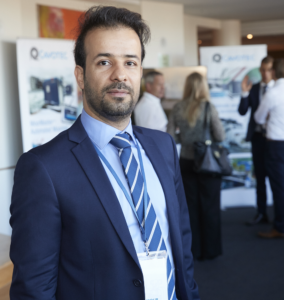 During the Baltic Port Conference 4-6 Sep, 2019 in Stockholm, the Docks The Future was introduced to audiences on 6 Sep, where he talked about the project and its contribution to defining ” the Port of the Future, meant as a near future (2030) in Europe” which should face challenges related but not limited to simplification and digitalization of processes, sustainability, emission reduction, energy transition, climate change, port-city interface and the use of renewable energy management.
During the Baltic Port Conference 4-6 Sep, 2019 in Stockholm, the Docks The Future was introduced to audiences on 6 Sep, where he talked about the project and its contribution to defining ” the Port of the Future, meant as a near future (2030) in Europe” which should face challenges related but not limited to simplification and digitalization of processes, sustainability, emission reduction, energy transition, climate change, port-city interface and the use of renewable energy management.

